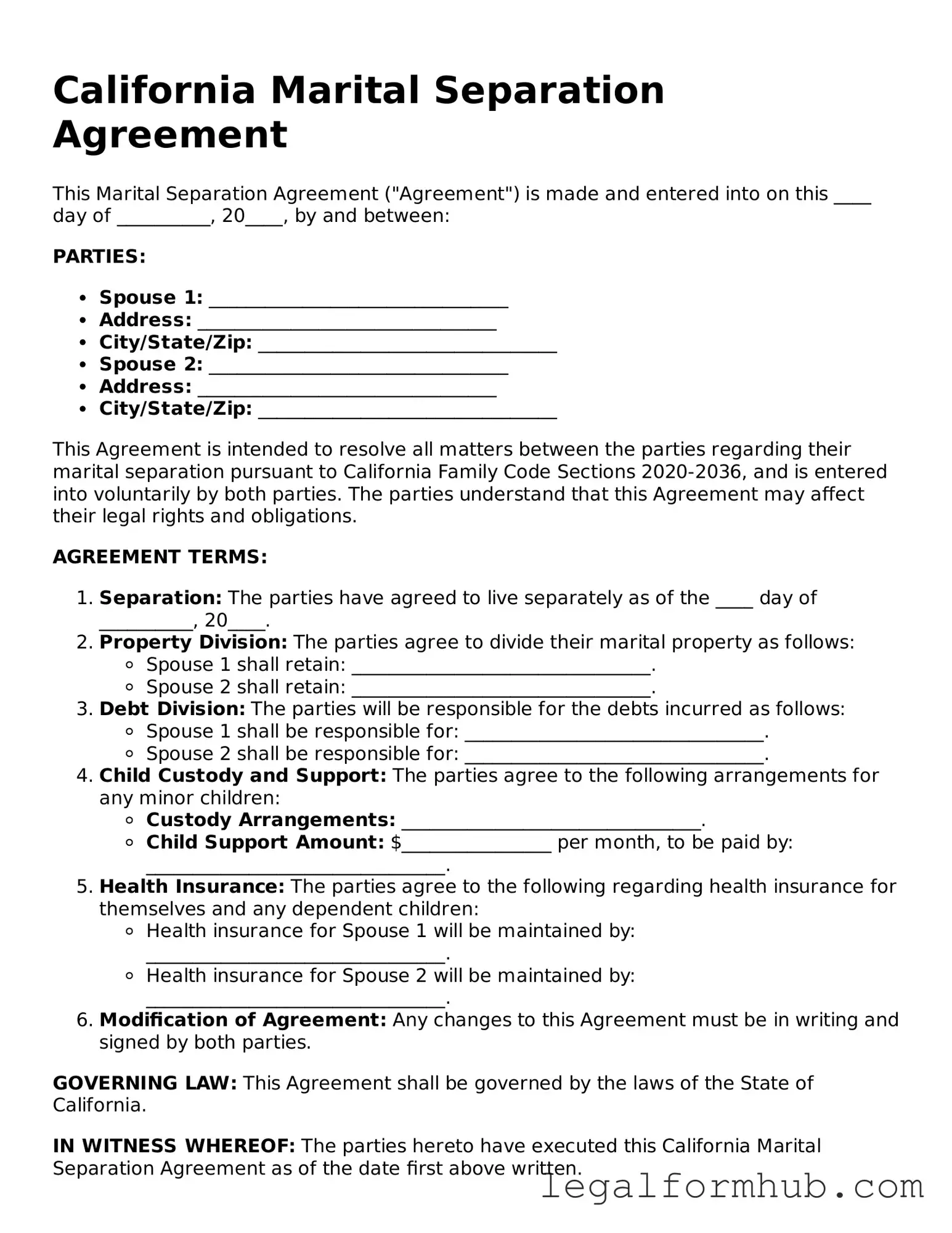The California Marital Separation Agreement is similar to a Divorce Settlement Agreement. Both documents outline the terms of the separation between spouses, including asset division, child custody, and support obligations. A Divorce Settlement Agreement is finalized when the couple decides to end their marriage, while a Marital Separation Agreement may be used when the couple chooses to live apart without formally divorcing. This document serves as a framework for managing responsibilities and expectations during the separation period.
Another document akin to the Marital Separation Agreement is a Cohabitation Agreement. This type of agreement is often used by couples who live together but are not married. Similar to a Marital Separation Agreement, it addresses property rights, financial responsibilities, and other issues that may arise during the relationship. Both agreements aim to clarify expectations and protect the interests of each party, although the context differs significantly.
A Prenuptial Agreement shares similarities with the Marital Separation Agreement as well. While a Prenuptial Agreement is created before marriage, it also outlines the division of assets and responsibilities in the event of a separation or divorce. Both documents help to establish clear terms regarding financial matters and can reduce conflict should the relationship end, although a Prenuptial Agreement is proactive, while a Marital Separation Agreement is reactive.
If you find yourself in a situation where you need to apply for disability benefits while navigating these agreements, understanding the process of filling out necessary forms is essential. The EDD DE 2501 form is a crucial document utilized in California for claiming disability benefits through the Employment Development Department (EDD). This form enables individuals to provide necessary information about their medical condition and work history to access financial support during times of disability. If you need assistance with filling out this form, Fill PDF Forms to get started!
The Separation Agreement in other states often mirrors the California Marital Separation Agreement. This document serves a similar purpose: to define the terms of separation between spouses. While the laws and requirements may vary by state, the fundamental goal remains the same—clarifying responsibilities and rights during the period of separation.
A Child Custody Agreement is another document that aligns closely with the Marital Separation Agreement, particularly when children are involved. This agreement specifically focuses on the custody and visitation rights of parents. In a Marital Separation Agreement, child custody provisions may be included, ensuring that both parents understand their roles and responsibilities during the separation.
A Property Settlement Agreement is similar to the Marital Separation Agreement in that it specifically addresses the division of marital property. While the Marital Separation Agreement may encompass broader terms regarding support and custody, a Property Settlement Agreement focuses solely on how assets and debts will be divided. Both documents aim to prevent disputes and provide clarity for both parties.
The Postnuptial Agreement is another document that has similarities with the Marital Separation Agreement. This agreement is created after marriage and outlines how assets and responsibilities will be managed in the event of separation or divorce. Like the Marital Separation Agreement, it can help clarify expectations and protect each party’s interests, although it is typically established while the marriage is still intact.
A Family Law Mediation Agreement can also be compared to the Marital Separation Agreement. This document results from mediation sessions where both parties negotiate terms related to their separation. Similar to a Marital Separation Agreement, it aims to resolve disputes amicably and set forth the agreed-upon terms regarding custody, support, and property division.
The Domestic Partnership Agreement is similar to the Marital Separation Agreement in that it outlines the rights and responsibilities of partners in a domestic partnership. Just as the Marital Separation Agreement clarifies terms for married couples, this agreement serves to protect the interests of partners who may not be married but wish to formalize their relationship. Both documents address financial and personal matters in the context of a partnership.
Lastly, the Uncontested Divorce Agreement can be likened to the California Marital Separation Agreement. Both documents are used when both parties agree on the terms of their separation or divorce. An Uncontested Divorce Agreement finalizes the divorce process, while a Marital Separation Agreement may simply set the terms for living apart. In both cases, the goal is to minimize conflict and establish clear guidelines for the future.
